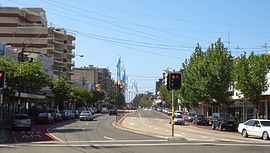개인소비지출가격지수
Personal consumption expenditures price indexThe PCE price index (PCEPI), also referred to as the PCE deflator, PCE price deflator, or the Implicit Price Deflator for Personal Consumption Expenditures (IPD for PCE) by the BEA, and as the Chain-type Price Index for Personal Consumption Expenditures (CTPIPCE) by the Federal Open Market Committee (FOMC), is a United States-wide indicator of the 국내 모든 개인 소비의 평균 가격 상승 2012 = 100을 기준으로 벤치마킹된다. 미국 소비자물가지수와 생산자물가지수 가격 등 다양한 데이터를 활용해 BEA의 국민소득 및 상품계정 내 GDP의 가장 큰 구성 요소인 개인소비지출에서 도출한 것이다.
개인소비지출(PCE) 척도는 미국 경제분석국(BEA)이 수집한 국내총생산(GDP) 내 소비의 구성요소 통계다. 가계의 실제 지출과 귀속 지출로 구성되며 내구성과 비내구재 및 서비스와 관련된 데이터를 포함한다. 그것은 본질적으로 개인을 대상으로 하고 개인이 소비하는 재화와 용역의 척도다.[1] PCE 물가지수의 변동성이 적은 척도는 보다 변동성이 크고 계절적인 식품 및 에너지 가격을 제외한 핵심 PCE(PCE) 물가지수다.
수 년 동안 하나의 지출 가중치를 사용하는 미국 소비자 물가 지수(CPI)라는 헤드라인과 비교하여, 이 지수는 당기와 전 기간의 지출 데이터를 사용하는 피셔 물가 지수를 사용한다. 또한 PCEPI는 고정기반을 선택하는 대신 1분기 가격을 전분기 가격과 비교하는 체인지 지수를 사용한다. 이 물가지수법은 소비자가 상대적 물가의 변동을 감안했다고 가정한다. 즉 가격이 오르는 상품에서 안정적이거나 하락하는 상품으로 대체했다.
PCE has been tracked since January 1959. Through July 2018, inflation measured by PCE has averaged 3.3%, while it has averaged 3.8% using CPI.[2] This may be due to the failure of CPI to take into account the substitution effect. Alternatively, an unpublished report on this difference by the Bureau of Labor Statistics suggests that most of it is from different ways of calculating hospital expenses and airfares.[3]
Federal Reserve
In its "Monetary Policy Report to the Congress" ("Humphrey–Hawkins Report") from February 17, 2000 the FOMC said it was changing its primary measure of inflation from the consumer price index to the "chain-type price index for personal consumption expenditures".[4]
Comparison to CPI
The differences between the two indexes can be grouped into four categories: formula effect, weight effect, scope effect, and "other effects".
- The formula effect accounts for the different formulas used to calculate the two indexes. The PCE price index is based on the Fisher-Ideal formula, while the CPI is based on a modified Laspeyres formula.
- The weight effect accounts for the relative importance of the underlying commodities reflected in the construction of the two indexes.
- The scope effect accounts for conceptual differences between the two indexes. PCE measures spending by and on behalf of the personal sector, which includes both households and nonprofit institutions serving households; the CPI measures out-of-pocket spending by households. The "net" scope effect adjusts for CPI items out-of-scope of the PCE price index less items in the PCE price index that are out-of-scope of the CPI.
- "Other effects" include seasonal adjustment differences, price differences, and residual differences.[6]
- See more at: https://www.bea.gov/help/faq/555
| Consumption category | CPI-U | PCE-UNADJ | PCE-ADJ |
|---|---|---|---|
| 식음료 | 15.1% | 13.8% | 17.0% |
| 집에서 먹는 음식 | 8.0% | 7.1% | 8.7% |
| 식량이 떨어져 있다. | 6.0% | 4.9% | 6.0% |
| 알코올성 음료 | 1.1% | 1.8% | 2.3% |
| 주택 | 42.4% | 26.5% | 32.9% |
| 렌트 | 5.8% | 3.4% | 4.1% |
| 소유자 등가임대료 | 23.4% | 12.9% | 15.9% |
| 기타주택 | 13.1% | 10.2% | 12.9% |
| 의류 | 3.8% | 4.5% | 5.5% |
| 의료 | 6.2% | 22.3% | 5.0% |
| 교통 | 17.4% | 13.9% | 17.3% |
| 자동차 | 7.9% | 5.3% | 6.5% |
| 가솔린 | 4.2% | 3.4% | 4.3% |
| 기타운송 | 5.4% | 5.2% | 6.5% |
| 교육 및 커뮤니케이션 | 6.0% | 5.4% | 6.7% |
| 레크리에이션 | 5.6% | 6.8% | 8.4% |
| 담배 | 0.7% | 1.0% | 1.2% |
| 기타재화 및 서비스 | 2.8% | 5.8% | 6.0% |
| 100% | 100% | 100% |
위의 차트는 예시되지만 현재 값을 반영하지 않을 수 있다. 위의 표의 비교는 지수의 성분에 대한 상대적 가중치가 변함에 따라 시간이 지남에 따라 달라질 것이다. CPI 기준가격과 가중치는 2년마다 조정된다.
위의 표는 PCE 디플레이터와 CPI-U 사이에 공통적으로 논의되는 두 가지 중요한 차이를 보여준다. 첫 번째는 주택의 상대적 중요성이며, 이는 부분적으로 위에서 언급한 범위 차이 때문이다. CPI는 소유자 등가 임대료의 큰 구성요소를 포함하며, 정의상 귀속가치로 실제 직접 지출이 아니다. 몸무게의 두 번째 큰 차이는 건강관리다. 이는 다시 지수의 정의와 사용된 설문에서 비롯된다. CPI는 PCE가 고용주가 제공한 의료보험을 포함하여 제3자가 가구를 대신하여 구입한 의료보험을 포함하는 가구의 지출비용만 측정한다. 미국에서 고용주 의료보험은 큰 구성요소로서 가중치 차이의 많은 부분을 차지한다.
또 다른 주목할 만한 차이점은 CPI 가격과 가중치는 가계 조사에 근거하고 있고 PCE는 사업 조사에 근거하고 있다는 것이다. 수식이 다른 한 가지 이유는 피셔-이데탈 수식에 필요한 모든 데이터가 월별로 우수하다고 여겨지지만 이용할 수 있는 것은 아니기 때문이다. CPI는 전월의 가격을 더 빨리 읽을 수 있는 실용적인 대안이다. PCE는 일반적으로 분기 말 이후 각 달에 3번씩 개정되며, 이후 NIPA 표 전체가 매년, 그리고 5년마다 다시 작성된다. 이러한 모든 개념적, 방법론적 차이에도 불구하고, 두 지수는 몇 년 동안 평균을 냈을 때 상당히 밀접하게 추적한다.[8]
See also
- Price index
- Gross domestic product deflator (IPD for GDP)
- Household final consumption expenditure (HFCE)
- Inflation
References
- ^ "Definition of 'Personal Consumption Expenditures - PCE'", Investopedia, Accessed 31-July-2012
- ^ PCE and CPI indices, Jan 1959 - Jul 2018: "FRED Graph - FRED - St. Louis Fed". fred.stlouisfed.org. Retrieved September 9, 2018.
- ^ Boskin, et al. "Consumer Prices, The Consumer Price Index, and the Cost of Living." Journal of Economic Perspectives - Volume 12, Number 1. Winter 1998, pp3-26.
- ^ "FRB: Monetary Policy Report to the Congress - February 17, 2000". www.federalreserve.gov. Retrieved September 9, 2018.
- ^ https://www.yahoo.com/now/does-producer-price-index-tell-190327824.html
- ^ "Archived copy". Archived from the original on July 27, 2018. Retrieved March 12, 2019.CS1 maint: archived copy as title (link)
- ^ https://www.nber.org/chapters/c12661.pdf
- ^ Moyer, Brian C.; Stewart, Kenneth J. "A Reconciliation between the Consumer Price Index and the Personal Consumption Expenditures Price Index" (PDF). www.bea.gov. Bureau of Economic Analysis. Retrieved September 7, 2014.
External links
Data
- Briefing.com: Personal Income and Spending
- Briefing.com: CPI (the core CPI as a comparison)
- Current News Releases from the Bureau of Economic Analysis (click on "Personal Income and Outlays", then skip to Tables 9 and 11 near the bottom.)
- St. Louis Federal Reserve FRED2 PCE data index
Articles
- Personal Consumption Expenditures - PCE
- FAQ: What is the "market-based" PCE price index?
- Implicit Price Deflator for Personal Consumption Expenditures - Referendum 47's Measure of Inflation
- FRB: Monetary Policy Report to the Congress - February 17, 2000
- TheStreet.com: Meet the Fed's Elusive New Inflation Target






